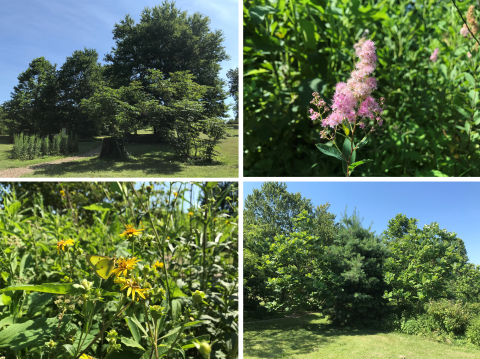Cumberland Mountain Region
 The Cumberland Mountain exhibit on the Walk Across Kentucky was begun in 2011. As this region is geographically the smallest in Kentucky, the same is true at The Arboretum. However, this collection is packed with botanical diversity and has over 95 trees per acre, more than double that of any other region.
The Cumberland Mountain exhibit on the Walk Across Kentucky was begun in 2011. As this region is geographically the smallest in Kentucky, the same is true at The Arboretum. However, this collection is packed with botanical diversity and has over 95 trees per acre, more than double that of any other region.
This exhibit includes a solitary pathway on a hillside which winds through a series of heavily planted raised mounds. The path leads up the hillside in an elevational gradient, in which a typical beech-hemlock forest at the entrance (bottom) transitions to a mixed mesophytic forest of magnolia, hickory, birch, maple, etc., and then transitions into a summit forest of chestnut and oak.
Native grasses and wildflowers were seed-sown on the mounds at the time of establishment, representing to some extent what a successional forest might look like.
Over time as the trees grow and shade out the collection, we will transition to a mixed understory of additional wildflowers, shrubs, and other shade-tolerant species indicative of the region.
Many interesting plants can be found in the Cumberland Mountains that are not present in other regions of Kentucky, including Fraser magnolia, yellow birch, and mountain maple. Ground nesting birds, rabbits, and a variety of insects are typically observed here, nesting in the mounds.
This will be an exciting area to watch evolve over time.
From "The Big Picture: Ecological Regions of Kentucky" by Dr. Julian Campbell:
“This remarkable region is a thin, 10-15 mile wide strip out of the Appalachian Plateaus that ancient seismic forces sliced (and diced in a few places), raised, and folded up at the edges, along its entire length. It extends for 120 miles, from ‘Pioneer’ in Tennessee, to the ‘Breaks’ of the Sandy River at the West Virginia border. Most rock is Pennsylvanian (as in most of the Appalachian Plateaus), but along outer edges, older Mississippian and Devonian rocks were also pushed up and exposed. As in upper strata of the Appalachian Plateaus, the central ‘Black Mountains’ of these Cumberland Mountains are rich in coal. A curious geological detail is the ‘Middlesboro Basin,’ which was apparently formed by the impact of a large meteorite.
"As might be expected, most of the biological diversity found on the Appalachian Plateau is also found in the Cumberland Mountains. In addition, the elevations are higher than anywhere else in Kentucky, and are distinctly cooler in places, especially along upper slopes and ridges of Black Mountain. Several northern or montane plants and animals are found here, but nowhere else in the state.”
